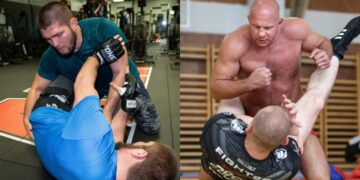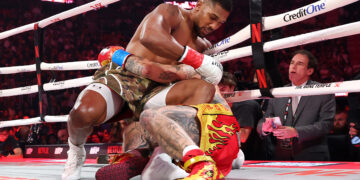
If you train in Brazilian Jiu-Jitsu, you will surely encounter opponents of various sizes and skill levels. One of the unique challenges for larger (or even medium-sized) grapplers is dealing with smaller and faster opponents. These smaller practitioners often possess a game that revolves around tricky footwork and explosive attacks that can catch even veteran practitioners. To be effective on the mats, one must adapt their strategies and techniques to neutralize these advantages. Today we will go over ways how to deal with smaller grapplers in BJJ.
Dynamics And Implications
Before diving into specific strategies, it is essential to understand the dynamics at play when a larger grappler faces a smaller opponent. Smaller practitioners often rely on speed and agility to create angles, escape from positions, and initiate attacks. They are typically more mobile and can exploit gaps and weaknesses in their larger opponent’s defense.
On the other hand, larger grapplers usually have an advantage in strength and weight, which can be used to control and pressure smaller opponents. However, relying solely on these attributes without proper technique can lead to frustration and inefficiency. Therefore, a balanced approach that combines strength with technical proficiency is crucial. On top of these, it is important to look into specific techniques that can effectively neutralize movement for as long as possible.
Now that we have a good understanding of the topic, let’s go over our recommendations to help deal with the smaller and faster grappler.
General Guidelines
In this video, BJJ blackbelt and popular YouTuber Stephan Kesting shares his recommendations on managing against smaller and faster opponents. We also included more tips in addition to Stephan’s suggestions below.
Improve Cardio
Cardiovascular endurance is crucial when facing smaller opponents who rely on speed and agility. Larger practitioners often have a natural strength advantage, but they may struggle to keep up with the relentless pace set by smaller, quicker grapplers. Improving your cardio through regular conditioning exercises such as running, swimming, and interval exercises can help you maintain energy levels and keep up with the fast tempo of matches. This increased stamina allows you to remain effective and composed throughout the match, reducing the likelihood of fatigue-related mistakes. If you are not a fan of supplementing your BJJ with regular workouts, you can simply add more movement to your grappling training to improve cardiovascular fitness.
Focus On Technique
While strength is an asset, relying solely on it can be a disadvantage against smaller, and typically technically better opponents. Emphasizing technique is essential for larger grapplers to efficiently deal with faster and more agile opponents. Work on refining your BJJ fundamentals whenever you can. Understanding and applying techniques effectively can neutralize the advantages of speed and agility, allowing you to capitalize on your strengths.
Play A Big Man’s Game
As a larger grappler, it is best to play to your strengths. Adopting a game plan that maximizes your physical attributes can help you control and dominate smaller opponents. Focus on techniques that leverage your weight and power, such as pressure passing, heavy top control, and submissions that utilize your strength advantage. Techniques focusing on heavy top pressure are good options for slowing down the opposition.
Additional Tips
1) Maintaining A Strong Base
A strong and stable base is fundamental when dealing with smaller opponents. Smaller grapplers tend to be more adept at off-balancing their opponents and executing sweeps. To counter this, larger practitioners must focus on maintaining a low center of gravity and a wide base. Keeping the knees bent and staying grounded can help resist sweeps and sudden movements.
Additionally, proper posture is essential. Avoid leaning too far forward or backward, as this can make it easier for the smaller opponent to manipulate your balance. Instead, keep your posture upright and your weight centered to maintain stability and control.
Effective Grip Fighting
Grip fighting is a critical aspect of BJJ, especially when facing a smaller, faster opponent. Controlling grips can limit the opponent’s ability to move and set up their attacks. Larger grapplers should focus on establishing strong grips on their opponent’s Gi or body to control their movement and limit their agility.
Breaking the opponent’s grip is equally important. Smaller opponents often use grips to control and create leverage. Learning effective grip-breaking techniques can neutralize their control and disrupt their game plan. Use your strength to your advantage by quickly and decisively breaking grips and re-establishing control.
Using Submissions Wisely
While larger practitioners may have an advantage in strength, it is essential to use submissions wisely and avoid relying solely on brute force. Smaller opponents often have excellent submission defense and can be difficult to tap out through strength alone. Focus on setting up submissions with proper technique and leverage.
Techniques such as the kimura, americana, and arm triangle can be effective against smaller opponents when applied correctly. Ensure that you are controlling the opponent’s body and isolating the targeted limb before applying pressure. Additionally, transitions between submissions can be useful for creating openings and catching the opponent off guard.
Defending Against Speed And Agility
Smaller opponents often use their speed and agility to escape from positions and initiate attacks. To counter this, larger practitioners must be vigilant and proactive in their defense. Anticipate the opponent’s movements and be ready to counter their escapes and attacks.
Maintaining control of the opponent’s hips is crucial for preventing escapes. Use your weight and grips to pin their hips down and limit their mobility. Additionally, staying tight and close to the opponent can prevent them from creating the space needed for escapes and attacks.
Creating A Planning
Dealing with smaller opponents can be mentally challenging, especially if they are constantly moving and creating scrambles. Mental toughness and patience are essential attributes for larger practitioners. Stay composed and avoid becoming frustrated if the smaller opponent is difficult to control.
Focus on executing your game plan and maintaining control. Patience is key when dealing with smaller, more agile opponents. Take your time to secure positions and control the tempo of the match. Avoid rushing or forcing techniques, as this can lead to mistakes and openings for the opponent.
Conclusion
Dealing with smaller opponents in BJJ is a more challenging feat than it seems. Using a strategic approach is best to maximize physical attributes, which in turn can turn the match in your favor. Always be mindful though of how you use your weight. Safety should be the top priority above anything else while on the mats.
You may also like:
The 6 Biggest Challenges You’ll Face When You Start Training BJJ
BJJ’s popularity has increased exponentially in the past three decades thanks to the growth of mixed martial arts. It’s a fun martial art to train regardless of your fitness level, and it’s an effective self-defence…
Congratulations on your decision to dive into the world of Brazilian Jiu-Jitsu (BJJ)! Get ready for many fun rolling sessions as you learn some of the cool submissions you’ve seen on TV and make many…
You might have social anxiety if you feel jittery during social interactions. It can lead to simple things like striking up a conversation at a party making you feel like your heart is about to…
Brazilian Jiu-Jitsu is an ever-evolving martial art with diverse techniques designed to give a strategic advantage in sparring and competition. Among these techniques, the tripod pass is a move that’s getting a lot of traction…
With Omar “Reug Reug” Kane’s emergence onto the world stage in Mixed Martial Arts, fight fans can’t help but wonder about the heavyweight star’s origins. He may be another colossal fighting figure that keeps the…
Brazilian Jiu-Jitsu is one of the most rewarding martial arts you can learn and it’s one of the newest. It is widely viewed as the best martial art for one-on-one combat against untrained opponents with…
Academy Award winner Russel Crowe is set to star in the sports action film ‘The Beast in Me,’ a title that alludes to the inner struggles and resilience of the characters. In what promises to…
Legendary British Muay Thai fighter, Liam Harrison, left his gloves in the cage following his KO defeat at the hands of Seksan at ONE 168 in Denver. This symbolic gesture, akin to the boxing adage…
Carb cycling is a dieting style that’s increasingly being used by MMA fighters or any martial artist looking to cut weight for their bouts and bodybuilders looking to keep their body fat low. It’s a…
If you are a fan of Muay Thai or combat sports in general, then there is no doubt that you have heard the name Superlek Kiatmoo9. The Thai “Kicking Machine,” has been on an absolute…
Mixed martial arts has evolved dramatically since its inception, as fighters constantly push the boundaries of what techniques are effectively used inside the cage. While techniques like the rear-naked choke, guillotine, and double-leg takedowns have…
You might be an introvert if you steer clear of crowded parties, excel at blending into the background during group activities, or feel hesitant about joining martial arts classes due to their larger group settings….




































